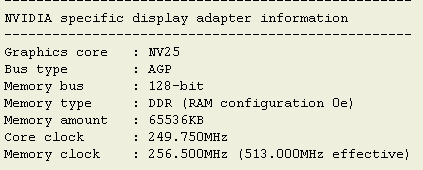Sytem Setup and Overclocking
|
Software
All benchmarks were conducted with vertical sync' disabled. Benchmarks were run 3 times consecutively, an average score was taken. The host system was configured for maximum performance. A fresh installation of Windows XP was used in both instances. We've seen the the MSI packs a punch on the features front, now is the time to see if it can deliver on the performance front, too. Interestingly, this is the first retail Geforce4 Ti video card we've tested that comes equipped with 'only' 64MB of on-board RAM, all others have had the full complement of 128MB as standard. We'll be able to ascertain whether the extra 64MB pays dividends or not. NVIDIA's reference Ti 4200 is available in two guises, both 64MB and 128MB. The rated clock-speeds for the 64MB variety are 250MHz core and 500MHz memory. We've previously been witness to MSI overclocking their video cards ever so slightly to gain a performance advantage over similar competing products. A quick inspection with RivaTuner, our preferred overclocking utility, shows this to be still the case with the Ti 4200. Here is a shot of the functioning clock-speeds without our intervention.
As you can no doubt see, the core speed is pretty much what one would expect. The memory speed, however, is a full 13MHz faster than the rated 500MHz DDR, or 2.6%. MSI obviously have more confidence in Hynix's RAM than NVIDIA apparently do. The memory running speed puts our test Ti 4200 reasonably close to the Ti 4400's rated speed of 550MHz. Overclocking We've previously been disappointed by the the lack of overclocking headroom, especially on the core, on the various Ti 4600s we've tested. So, it was with some anticipation that we started raising the clocks on the MSI Ti 4200 to see just how far the baby Ti could go. We tested the stability of the core by running the high dragothic test contained within 3DMark 2001SE. It's heavily GPU taxing, and is considered to be an excellent test for gauging potential GPU overclockability. Using Riva Tuner, we raised the GPU core speed in 5MHz increments and ran the dragothic test 3 times in a row to ensure basic stability. We passed 275MHz (Ti 4400s stock speed) without any difficulty whatsoever. I kept expecting it to crash. A wide grin appeared on my face as 300MHz, the stock speed of the flagship Ti 4600 came and went. I had to double-check the settings. After further exhaustive testing, I arrived at a rock-solid speed of 320MHz on the core, a 28% rise from the stock core speed of 250MHz. Indeed, 325MHz was stable in all but the dragothic tests. Some achievement for the baby Geforce4 Ti. We ran the lobby tests to check for memory overclockability. Starting at 513Mhz, we jumped up in 15MHz increments until artifacting became prevalent on-screen. It seems as if the Hynix on our Ti 4200 certainly lived up to its rated speed as we reached 607MHz DDR with perfect stability, a 21% increase over rated speeds. Overclocking had certainly been a success with our card. Do remember, ours is a sample of one, and your mileage may vary considerably. This is how RivaTuner saw our overclocking exploits, ones with no additional cooling whatsoever.
Sure does look impressive from a 'budget' card. I've known of quite a few Ti 4600s that couldn't manage 320MHz core, so the overclocking of this Ti 4200 is all the more impressive. The RAM, not being BGA, did become quite hot to the touch when overclocked. I feel that RAM heatsinks would have helped somewhat in this case. Let's get on to the benchmarks and see how it performs against its big brother, and the card that it effectively makes redundant, the Geforce3 Ti 500. I'm also interested in the effect of half the standard memory allocation will have on the results, especially the anti-aliasing and anisotropic filtering results. We'll conduct various benchmarks at 1024x768x32, 1280x1024x32, and 1600x1200x32 with the former being at the top of the following graphs at the latter at the bottom. |











